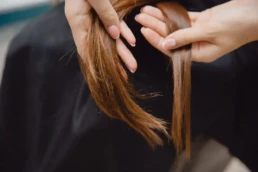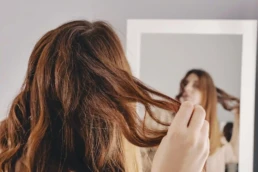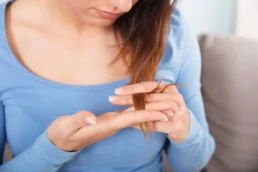With proper care and understanding, the key differences between healthy and unhealthy hair become more evident. Whether you’re trying to bring your hair back to life or simply maintain its current state, recognizing these signs can be incredibly helpful.
What Does Healthy Hair Look Like?
Healthy hair is often the picture of vibrancy—radiant, full of body, and smooth to the touch. When it’s in good condition, it reflects light naturally, offering a lustrous glow. Here are a few characteristics that healthy hair typically displays:
- Shiny and Glossy: Healthy hair gleams with a natural shine that’s not greasy or weighed down. Its appearance isn’t overly reflective, but it has a subtle, healthy glow.
- Smooth and Soft: When you touch healthy hair, it feels soft and silky, without any roughness or tangles. There’s a sense of movement, and it doesn’t feel brittle or dry.
- Strength and Resilience: Healthy hair is flexible and resilient. It doesn’t break easily under pressure, and it has the strength to withstand styling without becoming fragile.
- Even Colour: Whether you have dyed or natural hair, the colour appears rich and consistent, with no noticeable patches of dryness or fading.
How to Know If Your Hair Is Healthy
Healthy hair isn’t just about appearance—it’s also about how it feels and behaves. Here are some simple ways to assess if your hair is in optimal condition:
- Shine: Healthy hair naturally reflects light, giving it that glossy finish. If hair appears dull and lackluster, it may need some extra care.
- Movement: When you move, healthy hair moves too. If your hair feels stiff or heavy, it could be a sign that it’s lacking vitality.
- Texture: Run your fingers through your hair. If it feels smooth and untangled, it’s probably in good health. If it feels coarse or knotted, it may require nourishment.
- Elasticity: Gently stretch a single strand of hair. Healthy hair should bounce back without snapping, indicating strength and flexibility.

Signs of Healthy Hair
The characteristics of healthy hair extend beyond its appearance. Here are a few more signs of healthy hair to look for:
- Minimal Breakage: If hair breaks easily or sheds excessively, it may not be in its healthiest state. Healthy hair, however, is less prone to breakage and thinning.
- Frizz-Free: Healthy hair resists frizz, maintaining its smooth texture and shine even in humid conditions.
- Volume and Bounce: Healthy hair has natural fullness, even in fine or thin hair. It maintains body without appearing limp or flat.
- Healthy Scalp: A balanced scalp is key to hair health. If your scalp feels neither too oily nor too dry, it likely supports healthy hair growth.
What Does Unhealthy Hair Look Like?
On the other hand, unhealthy hair often exhibits noticeable signs of damage or imbalance. These signs may vary, but there are common indicators that suggest hair isn’t in the best condition:
- Dullness and Lack of Shine: Unhealthy hair may look flat and lifeless, losing its natural luster. It might appear dry or over-processed, with no reflection of light.
- Frizz and Unruliness: If hair tends to frizz or doesn’t hold its shape, it could indicate an unhealthy cuticle layer, which allows moisture to escape, leading to puffiness and frizziness.
- Breakage and Split Ends: One of the most obvious signs of unhealthy hair is visible split ends and breakage. Hair that is easily broken or fragile likely hasn’t been maintained well.
- Excess Oil or Dryness: Unhealthy hair can become either overly oily or excessively dry. A greasy scalp produces too much sebum, while a dry scalp fails to produce enough moisture.
- Thinning and Hair Loss: Thinning hair or noticeable hair loss can indicate a more serious underlying issue. This could result from poor hair care practices, diet, or even stress.

How to Improve Hair Health
Regardless of whether your hair is healthy or in need of restoration, there are a few key practices that can improve its overall condition:
- Regular Washing: Avoid over-washing hair, but do make it a habit to wash hair according to its needs. Shampooing too often strips hair of natural oils, while leaving it too long without washing can lead to buildup.
- Deep Conditioning: Deep conditioning treatments replenish moisture and repair damage. Adding a regular mask or treatment to your routine can work wonders.
- Heat Protection: Minimize heat styling, and when you do use heat tools, always protect hair with a heat-protectant spray. Excessive heat can damage the hair shaft and leave it weak and brittle.
- Regular Trims: Even when growing your hair out, trimming every few months helps remove split ends and keeps hair looking fresh and healthy.
- Scalp Care: Maintaining a healthy scalp is essential for healthy hair. Gentle exfoliation and scalp massages can promote circulation and help balance oil production.
- Proper Nutrition: Eating a balanced diet with plenty of vitamins and minerals supports healthy hair growth. Ensure that your diet includes essential fatty acids, biotin, and zinc to maintain hair vitality.

The Best Products to Improve Hair Health
Using the right products can make a significant difference in improving and maintaining your hair’s health. Aveda’s plant-powered formulas are designed to nourish and repair hair naturally. The Aveda Botanical Repair™ line is ideal for strengthening damaged hair, while the Nutriplenish™ collection delivers deep hydration with nutrient-rich ingredients. For scalp care, the Scalp Solutions™ line helps balance oil production and promotes a healthy environment for hair growth. Incorporating these high-quality products into your routine supports your journey to achieving strong, shiny, and resilient hair.
Conclusion: Healthy Hair vs Unhealthy Hair
The contrast between healthy and unhealthy hair is more than skin deep. Healthy hair shines, feels soft, and has volume and elasticity, while unhealthy hair looks dull, frizzy, and is prone to breakage. With a balanced approach to care, nourishment, and styling, healthy hair is within reach. Recognizing the signs of healthy and unhealthy hair allows you to adjust your hair care routine and make the necessary changes for beautiful, strong locks. Whether it’s by addressing product choices or giving your hair the occasional break from heat styling, you’ll be on the path to healthier, happier hair in no time.

